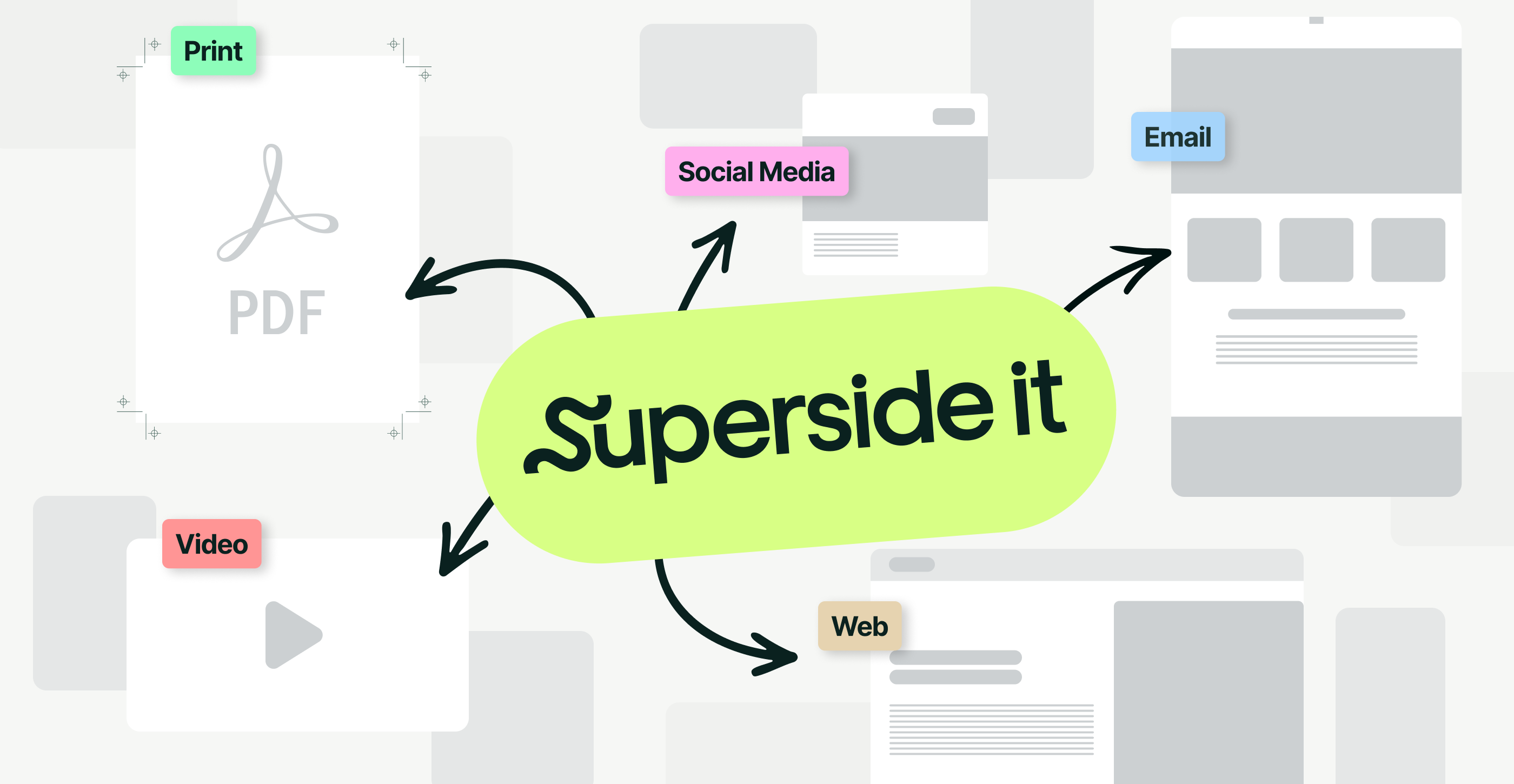
Well-executed integrated marketing campaigns help enterprise brands stand out in an oversaturated marketplace. When your creative assets all tell the same brand story, people notice. These nine examples demonstrate how creativity, consistency and a clear marketing strategy can drive results across channels.
Integrated cross-channel marketing goes beyond simply being present on various platforms. It’s about making every asset, from ads and emails to social posts and events, part of one clear story.
And, in a world where people see up to 10,000 ads a day, consistency and creative excellence is what helps brands stand out and be remembered.
When done well, integrated marketing creates a unified brand experience at every touchpoint and drives results. Across numerous accounts, we’ve also found that when integrated campaigns are driven by standout creative, they deliver strong ROI for our enterprise customers.
On the hunt for campaign examples and best practices? This article highlights nine integrated marketing campaigns that get campaign execution and creative excellence right, with insights from Superside’s very own Integrated Marketing Manager, Sofía Bittolo.
What is integrated marketing?
Integrated marketing unites Paid, Owned, Shared and Earned media (the essential pillars of the widely adopted PESO model) into a single, cohesive strategy. Under this model, brands use several channels in concert to amplify their reach and impact.
Source: SpinSucks
With integrated marketing, the aim is to deliver a consistent brand message or story across all customer touchpoints, from advertising and PR to social media, content marketing, email and events.
When campaigns use unified messaging and creative elements across multiple channels, formats and tactics, they help build brand recognition and deepen trust. In our experience, integrated marketing only succeeds when powerful creative sits at its core.
Why strong creative drives integrated marketing campaigns
You can’t run a successful integrated marketing campaign without standout creative that ties everything together.
Creative supports your brand—and your brand shapes the impression you leave on audiences, prospects, and business partners. Your business has a digital footprint that lives in the way others interact with your brand—whether you’re investing heavily in creative or keeping things lean and simple.

Here’s why it matters:
1. Unique creative grabs attention: Most ads don’t hold users’ attention for even three seconds. When you combine emotional narratives (even humor) with visually rich formats, attention surges by up to 106%.
Creative is how you connect with your prospects and customers. It’s what inspires them, makes them smile, makes them feel understood, or gets them excited. It’s one of the most powerful tools a business has to create meaningful engagement.

2. Good creative builds brand recall: Consistency pays off. Brands that stick to recognizable visuals and messages see better brand recall and a 10-20% revenue lift.
3. Great creative builds trust: 73% of consumers say they trust brands more when they maintain a cohesive visual identity. The same design system used across channels builds familiarity and credibility at every touchpoint.
4. Standout creative drives good decisions: Standout, emotive creative drives action. When campaigns are optimized for attention, brand recall climbs by 74% without any extra spend. This is why every integrated marketing communications plan must align around a consistent message that resonates deeply with the target audience.
Superside has seen this play out with customers like Mitto, Antler and Imperfect Foods. In each instance, unified, high-quality creative and brand consistency drove stronger engagement and conversions across channels.
We’ve also seen firsthand how easy it is for brands that pair integrated marketing creative with customer feedback to adjust quickly and keep their campaigns relevant.
In integrated marketing campaigns, creative is the thread that ties everything together. From paid ads to organic content, virtual events to in-person conferences—creative is what helps people recognize your brand, connect with your values, and really consider your business

Why integrated marketing matters for enterprise brands
Market research shows that integrated marketing campaigns are 31% more effective at building brand equity than those that are not.
Yet, 70% of companies still operate without a fully integrated marketing strategy.
Enterprises face four main challenges with integrated marketing: prioritization and focus, brand alignment, creative capacity and speed, and performance measurement. Without clear priorities, teams spread themselves thin and become reactive. Messaging drifts across teams and channels, creative demands outpace resources, and without tying performance to strategy, it’s harder to learn, optimize, or scale what works.

Without this strategic layer, your enterprise brand potentially misses out on:
- Simplification: Large organizations juggle dozens of campaigns and customer touchpoints. An integrated marketing approach simplifies and streamlines the campaign planning and execution process.
- Clarity: A single, cohesive brand story means customers, employees, investors and other stakeholders can instantly recognize your brand wherever they encounter it. A well-integrated marketing campaign makes it crystal-clear who you are and what you sell.
- A competitive edge: Integrated marketing is used to consistently reinforce a company’s strengths and unique value proposition. It builds a clear, repeatable narrative that tells customers exactly what the brand stands for and why it’s a better choice than competitor brands.
Integrated marketing also improves accountability. It becomes easier to track performance, plan future campaigns and build a powerful, widely recognizable brand.
Managing marketing across many channels isn’t just a coordination task—it’s a creative and strategic challenge. It’s crucial to have the right systems and partnerships in place, to be able to scale without losing impact.

To learn how strategic expertise can elevate your integrated marketing campaigns, see our marketing strategy consulting article.
9 integrated marketing campaigns that mastered creative consistency
Keen to see integrated marketing in action?
These nine omnichannel marketing examples demonstrate how a well-executed strategy can bring superb creative, the right marketing channels and excellent creative execution together to meet business goals from brands that have hit the “Just Superside It” button on their creative.
1. Mitto: How Superside orchestrated a cohesive brand experience
Source: Mitto by Superside
Who they are: Mitto is a global messaging platform that helps brands connect with customers worldwide.
The challenge: Rapid growth had left Mitto with a fragmented brand identity. The company’s digital ads didn’t match their landing pages, and tradeshow booths looked like they belonged to another brand .
The objective: Mitto wanted to unify its fragmented brand across all marketing channels as part of an integrated marketing campaign. They wanted every digital and physical touchpoint to tell a single cohesive story.
Channels leveraged:
- Digital ads to build awareness across marketing channels.
- Landing pages for a seamless post-click experience.
- Direct cross-channel marketing and tradeshow collateral to bring the same creative language to in-person events.
Creative execution: Superside built a complete visual system for Mitto. Bold colors, clean typography and a unified tone tied ads, landing pages and event materials together. Templates made it easy for the creative team to produce new assets quickly and maintain consistency across all assets.
Why it worked: The integrated marketing campaign did away with mismatched creative to transform Mitto into a recognizable, unified presence. Every channel reinforced the same brand identity. A unified marketing message and matching creative ensured helped the brand to reach their target audience effectively and set a solid foundation for more effective future campaigns.
Superside ensures creative consistency and quality by acting as a strategic partner in integrated marketing, not just a production arm. With clear briefs, strong collaboration, and early involvement, the team works fast without sacrificing quality. Specialist designers, led by experienced leaders, uphold brand standards and tie every asset directly to marketing goals—delivering impact, not just output.

Key takeaways:
- Use a single creative system across digital advertising, events, landing pages and other creative assets.
- Double-check that every campaign asset aligns with the same brand identity and message.
- Prioritize brand consistency in your integrated marketing campaigns and use templates to simplify scalability.
2. Antler: How Superside rebranded a global VC firm at startup speed
Source: Antler by Superside
Who they are: Antler is a global venture capital firm that backs early-stage founders.
The challenge: After a period of rapid growth, Antler needed a modern brand identity that matched their ambitions. They asked Superside to deliver a number of new brand assets within four months.
The objective: To create a consistent, integrated presence across various marketing channels with a single creative strategy that could roll out fast and scale globally.
Channels leveraged:
- A reimagined website.
- Social media marketing and templates.
- Investor reports and pitch decks.
- Digital event assets, Zoom backgrounds and content marketing tactics.
- Videos to tell Antler’s founder-first story.
Creative execution: Superside developed a bold, modern brand system with dynamic color, clean typography and scalable templates. Through real-time collaboration with Antler’s global marketing team, assets were aligned across time zones. The result was a seamless rollout, where every channel, from pitch decks to social media, looked and felt like it was part of one unified campaign.
Why it worked: Superside’s integrated marketing approach gave Antler a clear, recognizable identity everywhere it showed up. Consistency across decks, websites and LinkedIn banners created confidence for investors, founders and partners worldwide. The approach was also in line with current digital marketing trends.
Key takeaways:
- A cross-channel rebrand requires a single creative direction.
- Templates can unify and speed up delivery across markets.
- Tight collaboration quickly makes global integration possible.
3. Imperfect Foods: How Superside scaled creative for growth
Source: Imperfect Foods by Superside
Who they are: Imperfect Foods is a grocery delivery company on a mission to fight food waste.
The challenge: Rapid expansion into new markets stretched Imperfect Foods’ creative team to the limit. They needed to produce more content across channels and retain the quirky, human tone that made the brand stand out.
The objective: To increase creative output as part of an integrated marketing campaign, to protect the brand personality and to drive consistency across channels.
Channels leveraged:
- Paid social advertising (static and motion ads).
- Billboards in new markets.
- Event branding and localized collateral.
Creative execution: Superside built a set of motion templates that turned the brand’s static user-generated content (UGC) into short, dynamic videos. This approach made it easy to adapt creative for different markets and channels at speed. By tying social, OOH and event assets together with one creative system, every touchpoint became part of the same powerful campaign.
Why it worked: Creative production scaled 10x while quality remained firmly in check. The campaign’s cost-per-acquisition (CPA) dropped by 25%, and the click-through rate (CTR) improved by 47%. Most importantly, the brand’s playful tone stayed intact across every ad, billboard and event.
Ultimately, our integrated marketing approach allowed Imperfect Foods to tailor creative for each target segment and still tell a single, consistent brand story.
Key takeaways:
- Scale doesn’t have to translate into a diluted brand identity.
- A unified creative system works to tie campaign messages and creative together across paid, social, OOH and events.
- Templates enable teams to move quickly and maintain consistency.
4. Kia Australia: EV buzz with a zombie twist
(Image source: Nick and Pat)
Who they are: Kia Australia, the automaker behind the EV9 and a long-time sponsor of the Australian Open.
The challenge: To introduce a new EV range in a crowded market and make Kia stand out from other electric vehicle brands.
Objective: Use the Australian Open to launch an integrated campaign that engages target customers across multiple channels and raises awareness about the new EV range.
Channels leveraged:
- TV and digital advertising.
- Social media video content.
- On-site experiential activations at the Australian Open.
- AI-personalized DOOH billboards.
Creative execution: The entire campaign brought a bold concept to life: A cinematic zombie apocalypse where quiet, capable Kia EVs help suburban Australians survive.
The idea was extended beyond screens. Live brand experiences at the tournament allowed fans to step into the story, while AI-personalized billboards delivered messages tailored to the model and location. Every touchpoint, from TV ads to on-site activations, worked together to create a much-talked-about integrated campaign.
Why it worked: The unique narrative broke through the noise, helped the company earn significant organic media coverage, and was talked about and shared well beyond the tournament. Kia connected a physical experience with digital storytelling to reach a broad target audience and drive EV sales. The campaign also increased brand awareness.
Key takeaways:
- A great concept can span multiple channels (e.g., TV, digital, live events and DOOH).
- Integrated stories = connected brand journeys = credibility and trust.
- Personalization is most effective when grounded in a bold central idea.
5. Nike: “So Win” inspired a new generation of athletes
(Image source: Nike.com)
Who they are: A global sportswear leader known for innovation in sport and culture.
The challenge: Ahead of a major sports year, Nike needed to reconnect with Gen-Z fans and women in a way that felt authentic and inclusive.
The objective: To connect with women and inspire a new generation with a video and global integrated campaign that puts women athletes and fans at the heart of the story.
Channels leveraged:
- A 60‑second Super Bowl spot.
- TV and video shared on online platforms.
- Social media posts and athlete‑driven content.
- Outdoor and in‑store activations.
Creative execution: The fast-paced “So Win” brand anthem was narrated by Grammy-winning rapper Doechii and featured stars like Jordan Chiles, Caitlin Clark, Sabrina Ionescu, Sha’Carri Richardson, A’ja Wilson and Sophia Wilson. The video celebrated the love of sport through quick, vibrant cuts that showed both triumph and struggle. Adapted across TV, social and retail experiences, the same bold tone tied everything together.
Why it worked: “So Win” became one of the most talked‑about ads during Super Bowl weekend and connected with a younger audience worldwide. By extending the anthem and video into social content, Nike created an integrated story that felt real and community‑driven.
Key takeaways:
- A single, clear creative idea can unify channels.
- Authentic athlete voices build trust and participation.
- Integrated storytelling can turn campaigns into culture.
5. Apple: “Shot on iPhone” turned users into creators
(Image sources: Apple Instagram, AdWeek)
Who they are: A global leader in consumer technology and design innovation.
The challenge: To demonstrate the iPhone’s camera capabilities in a way that felt authentic and user-driven (i.e., a step away from a traditional product ad).
The objective: To build a global, integrated campaign that celebrated real users and their creativity and ultimately turn UGC into Apple’s most powerful cross-channel marketing asset.
Channels leveraged:
- Outdoor billboards.
- TV and digital ads.
- Social campaigns with the #ShotOniPhone tag.
- Apple-owned content hubs.
Creative execution: Apple centered the 10-year-old campaign on the work of everyday iPhone users. Striking photos and videos shot on iPhone became the hero of every format, from giant outdoor billboards to social feeds. The clean, minimal layout put all the focus on the imagery. Local content was featured in each market, which made the campaign feel both global and personal.
Why it worked: For nearly a decade, “Shot on iPhone” has shown the power of simplicity and consistency. The same core creative idea, which showcases authentic user work, has been consistently applied across every channel to create one of the most recognizable integrated marketing campaigns in the world. This approach built credibility, connected the brand with a global audience, and proved that great creative doesn’t always come from a studio.
Key takeaways:
- Simplicity can be the ultimate integration strategy.
- A single creative idea can work across billboards, social and video.
- Global consistency works best when paired with local relevance.
6. The New York Times: “The truth is hard” rebuilt trust through simplicity
(Image sources: Droga5.com, Medium.com)
Who they are: One of the world’s most influential news organizations.
The challenge: In an era of misinformation and mistrust in the media, the New York Times needed to reaffirm its authority, strengthen its relationship with readers and grow subscriptions.
The objective: To launch a bold, integrated campaign that underscored the importance of fact-based journalism and restored public confidence in the Times.
Channels leveraged:
- TV spots.
- Outdoor billboards.
- Social media storytelling.
- Live events and panel discussions.
Creative execution: The NYT chose simplicity over spectacle. Its “The truth is hard” campaign used plain typography and short, powerful statements to immediately catch attention. Launched during the Oscars, this minimal, disciplined design approach ran consistently across billboards, TV, social and live events. The campaign’s unified message cut through the noise and became impossible to ignore.
Why it worked: The campaign’s clarity and consistency turned it into a cultural moment. In the second quarter of 2017, NYT surpassed two million digital-only subscribers, a first for any news outlet. More importantly, the campaign positioned the publication as a champion of truth in a climate of skepticism.
Key takeaways:
- A disciplined creative system amplifies impact across channels.
- Minimal, bold design can be more powerful than complex creative.
- A unified message builds trust and delivers measurable results.
8. Old Spice: “The man your man could smell like” gave a legacy brand a viral makeover
Who they are: A classic men’s grooming brand under Procter & Gamble, long known for its traditional, “old-fashioned” image.
The challenge: By the late 2000s, Old Spice started to lose relevance with younger consumers. It needed to refresh its image, regain cultural relevance and reach a digitally native audience. At the same time, it also had to retain its current customer base.
The objective: To reposition the brand, grow sales and change how women perceive men’s grooming products, since research revealed that women make 60% of body wash purchases.
Channels leveraged:
- Super Bowl TV spot.
- Social media platforms, including YouTube, Twitter and Facebook.
- Earned media driven by viral sharing.
Creative execution:With the help of Wieden+Kennedy, Old Spice built a bold, humorous campaign around this line: “The man your man could smell like.” The concept introduced a confident, over-the-top character (Isaiah Mustafa), who delivered fast-paced monologues in a single take.
Following the Super Bowl launch, the company sent 186 personalized response videos. They replied directly to tweets, Facebook comments, Reddit threads and even celebrities to turn fans into active participants. This blend of broadcast and digital interaction created a seamless, cohesive experience across channels.
Why it worked: The campaign flipped the brand’s outdated image on its head. Within a week, videos had over 40 million views, site traffic surged 300% and sales jumped by 107%. Old Spice merged humor, culture and personal engagement to re-establish itself as a relevant, modern brand.
Key takeaways:
- Good customer insights and a precise brand positioning can spark creative reinvention.
- Real-time engagement on social channels can amplify broadcast campaigns.
- Personalized responses foster stronger customer connections.
- A simple idea executed consistently across media can completely transform a brand.
9. Coca-Cola: “Share a Coke” a masterclass in personalization at scale
(Source: Coca-Cola)
Who they are: Coca‑Cola, one of the world’s most iconic beverage brands.
The challenge: As beverage consumption among young adults declined, Coca-Cola sought to refresh its image and reconnect emotionally with its younger target audience.
The objective: To boost sales, rev up engagement and make the brand feel more personal and relevant.
Channels leveraged:
- Paid media (TV, outdoor and print).
- Social media platforms (Facebook, YouTube and Twitter).
- In‑store activations, pop‑ups and direct marketing.
Creative execution: Launched in Australia in 2011, Coca‑Cola replaced its logo with popular names and terms like “Bestie” on bottles and cans and encouraged people to “Share a Coke” with friends. Social ads and posts encouraged consumers to share photos of their personalized bottles, while experiential pop-ups and QR codes invited them to create virtual cans online.
Why it worked: The campaign delivered a personal touch, generating interest on a global scale. Over 250 million named bottles were sold in Australia alone, with sales rising 2-7% in markets such as the U.S. and the U.K., and Coca-Cola gained millions of social media followers.
The beverage giant blended personalization with integrated storytelling to turn its packaging into an experience customers won’t easily forget.
This year, Coca-Cola relaunched its iconic “Share a Coke” campaign. The campaign once again emphasizes shareability, customization and entertaining online experiences to engage younger (Gen Z) consumers.
Key takeaways:
- Personalization can refresh a heritage brand.
- Integrated campaigns are most effective when they seamlessly bridge digital and physical touchpoints.
- A simple, scalable idea can connect with millions worldwide.
Need more inspiration? Our list of the 25 best multichannel brand campaigns in 2026 will help you brainstorm your own integrated marketing campaigns.
Superside’s approach to integrated marketing campaigns
At Superside, we believe every integrated campaign is only as good as the creative behind it. That’s why we embed our creative team directly into our customers’ workflows. There’s no better way to keep the multichannel campaign planning process and creative execution on track.
Superside is built for enterprise brands that need creative teams who can deliver speed, volume, and quality. With one subscription, you get top-tier talent across motion, video, design, copy, and more—plugging into your workflows at any stage. A dedicated project manager and our platform streamline collaboration, boosting output without adding headcount or straining your team.

Our approach focuses on three essentials for enterprises:
- Consistency: A consistent brand experience builds brand recognition and trust across channels. From social to video, print to live events, every asset we create for our enterprise customers looks and feels like it’s part of a single, powerful story.
- Speed: Our AI-driven production model is built for rapid turnaround. We deliver high-quality creative fast to build and maintain campaign momentum.
- Scale: We help global brands manage complex campaigns, create large volumes of creative for multiple markets and stakeholders, and keep channels and messages aligned.
What sets us apart is our creative quality, our ability to scale, and the way we use AI to move faster without compromising craft. That’s why leading enterprise brands choose Superside as their creative partner.

With Superside, every touchpoint, from digital to in-person, becomes part of a unified experience that delivers the right campaign message at precisely the right moment to help you reach your campaign and business goals.
Plan your next integrated campaign with Superside
Creative is the heartbeat of any integrated marketing campaign, especially at the enterprise level. You can have all the budget in the world, but if your creative doesn’t capture the hearts and minds of your target customers, you simply won’t get the attention you deserve.
Here’s where a superb creative partner, like Superside, can be a lifeline. As the world’s top AI-powered creative service, we combine a global team of creatives, advanced AI tools and workflows, and a robust project management platform to deliver unified, integrated marketing campaigns for ambitious enterprises fast.
We over-invest in a smooth onboarding process, create brand toolkits for consistency and ensure fast review cycles, so you can move from concept to completion without delays.
Why risk another fragmented, ineffective marketing campaign when you can simply Superside it?






















